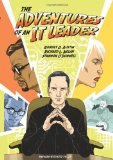In the immortal words of Pogo, “we have met the enemy, and he is us.”
The long-held stereotype of IT portrays us as uncooperative, unable to integrate socially, always arguing over nits, and deeply, intractably immersed in our own tunnel vision and parochial perspective.
That stereotype has held us back, as individuals and as a profession: it’s actually one root cause for the oft-lamented situation of the CIO needing a seat at the executive table and not getting it.
Now a whole movement has arisen that unfortunately reinforces that negative perception of IT people, a movement that coalesces around the Twitter hashtag #NoEstimates (all movements need a Twitter hashtag now, it appears). It started with long screeds about how inaccurate estimates are for software development: they’re nothing more than guesses; “there is nothing about them that makes them necessary, or even beneficial to the actual creation of software”. They’re a “wasteful and deceptive practice“, lies, and needing them is even comparable to how heroin users need their heroin. You can’t predict the future, these estimate detractors insist. The #NoEstimates rhetoric has become increasingly harsh, and replete with drastic imagery: estimates are a “game of fools“; an “inherited disease for the industry“; “we predict like gypsy ladies.” In what seems at times to be some kind of “top the previous hyperbole” competition, estimates have even been referred to as “management by violence”.
This sort of overreaction, this IT resistance to estimates, isn’t really wholly new, of course. More than once, I’ve watched in horror as an IT person earnestly explained to a company’s senior management how predicting systems delivery is so very difficult and so very filled with uncertainty, justifying how (for example) they couldn’t possibly commit to having a system deployed in a particular quarter. One time, I witnessed the VP of Sales in particular having zero patience with that: “Hey, I get asked to set my sales quotas way in advance based on my best professional judgment; what makes you folks in IT think that you should be an exception?” Business runs on goals and commitments, and on the “best judgment” estimates that help create those goals and commitments. And everyone in the room seems to understand that, except IT.
Setting achievable, concrete goals is healthy, in business and in life. Making solid, reasonable commitments is healthy. Taking responsibility for meeting one’s commitments all or at least most of the time is natural and should be encouraged. And if you’re perceived as constantly wailing that you’re different and special, in fact so special that you believe you can’t really be expected to state when you’ll be done? That’s a non-starter. This blog post is an introduction to how some IT practitioners have been pulled in by the seductive but ultimately wrongheaded NoEstimates claims, and what the resulting implications are for our industry.
What’s #NoEstimates about? Well, its proponents are actually quite slippery on providing any solid definition, reflexively pushing back whenever anyone tries to summarize it for them, and they often prefer to vaguely say it’s just “a hashtag for a concept about alternatives to estimates and how they might help make better decisions.” However, it seems to boil down to a virulent and unshakable base conviction that estimates are utterly horrible, for all the reasons stated above and more. Using estimates allegedly leads to chronic abuse of developers by management, cements inflexibility into projects, and disturbs developer “flow”. The sole alternative to estimates that the NoEstimates advocates clearly identify, however, seems to simply restate the age-old Agile principles of small teams, user stories sliced into doable chunks, use of “drip funding” so as to achieve a predictable fixed cost, and software delivery “early and often”. They point out that software project scope tends to change drastically and frequently during such frequent delivery, and argue that this scope variability allows projects to be declared as done and successful, long before and without ever having actually delivered all the upfront-identified desired functionality.
Over the next two blog posts, I’ll first lay out the reasons to see considerable value in a software development estimating process and its outcomes, and then respond to the myriad NoEstimates complaints that are levied against estimates as used for software development. But we’ll start here, as an intro, just with invoking basic common sense about life and business.

